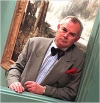Patrick McCaughey

Patrick McCaughey is former Director of the National Gallery of Victoria, the Wadsworth Atheneum in Hartford Connecticut, and the Yale Center for British Art. His most recent book is Strange Country: Why Australian Painting Matters (2014). His other works include Voyage and Landfall: The Art of Jan Senbergs (2006). He writes regularly for the Times Literary Supplement and Australian Book Review. He lives and works on the banks of the Quinnipiac River in New Haven, and has recently finished editing Fred Williams: Diaries 1963–1970 for the Miegunyah Press.
TarraWarra Museum of Art’s (TWMA) summer exhibition Assembled: The Art of Robert Klippel can only reinforce his reputation as Australia’s foremost modern sculptor. Yet he lacks the public reputation of his contemporary painters – John Olsen, Fred Williams, John Brack, and so on. Klippel (1920–2001) is known largely, if not exclusively, to the world of art. This exhibition may right that hi ... (read more)
Five years ago, the J. Paul Getty Museum acquired Édouard Manet’s Jeanne (Spring), 1882, for US$61 million – a record for the artist. It was a bold acquisition, for later Manet – he died in 1883 – has never enjoyed the critical esteem of the earlier. Absurdly so, if you recall that the incomparable Bar at the Folies Bergère was the Salon companion to Jeanne. According to Scott Allan, Jea ... (read more)
Philip Johnson – lagging well behind the founding fathers – may not be the most profound architect of the twentieth century. Nor does he have the resonance of Louis Kahn or the form-changing genius of Frank Gehry, among his contemporaries. Yet the pattern of twentieth-century architecture cannot be fully understood without him. Mark Lamster’s biography lodges him vividly in that pattern. A c ... (read more)
A shift in the European mind is taking hold. The stable democracies of Germany and the Netherlands contrast sharply with an unstable France and a demagogic Italy. The northern tier has an increasing authority, politically and culturally. Art historically, the Amsterdam–Berlin axis challenges the hegemony of the Paris–Rome accord. The reopening of the Rijksmuseum in 2013 after ten years of clos ... (read more)
Some time ago I appeared on a morning radio program with a prominent guru of Australian culture who roundly declared that Andy Warhol was ‘a one trick pony’. Neither remonstration nor persuasion could help the guru out of his imperturbable complacency. He had summed up Warhol in a sentence – what more need be said?
... (read more)
The geography of art post 1945 has a boringly settled look and needs disturbing. This engaging and readable book makes a useful starting point. The standard view begins with the switch of the centre from Paris to New York, and so it remained for the next fifty years or so until the shoals of post-minimalism washed up on the stony beach of postmodernism.
... (read more)
Barry Hill’s collection of essays from the last four decades is commanding and impressive. Few could match his range of subjects: from Tagore to John Berger, Lucian Freud to Christina Stead – all, for the most part, carried off with aplomb. He catches the ‘raw’ edge of Freud’s studio – ‘worksite’ as Hill calls it – ‘the sea of bare boards that rise into so many paintings, the t ... (read more)
Elizabeth Hardwick is, unfairly, better known outside of New York as Robert Lowell’s second wife, who heroically endured twenty-three years of tumultuous and tortuous marriage. She inspired his finest love poetry:
All night I’ve held your hand,as if you hada fourth time faced the kingdom of the mad –its hackneyed speech, its homicidal eye –and dragged me home alive …
Sleepless, you hol ... (read more)
Tate Modern excelled itself with its Giacometti retrospective. It’s not easy to take a familiar modern master and return a new and compelling view of his work. Many years ago, MoMA in New York failed the challenge abysmally. They had nothing new to say about the artist and went through the motions of a retrospective. Worst of all: you came away thinking that Alberto Giacometti (1901–66) was ti ... (read more)
